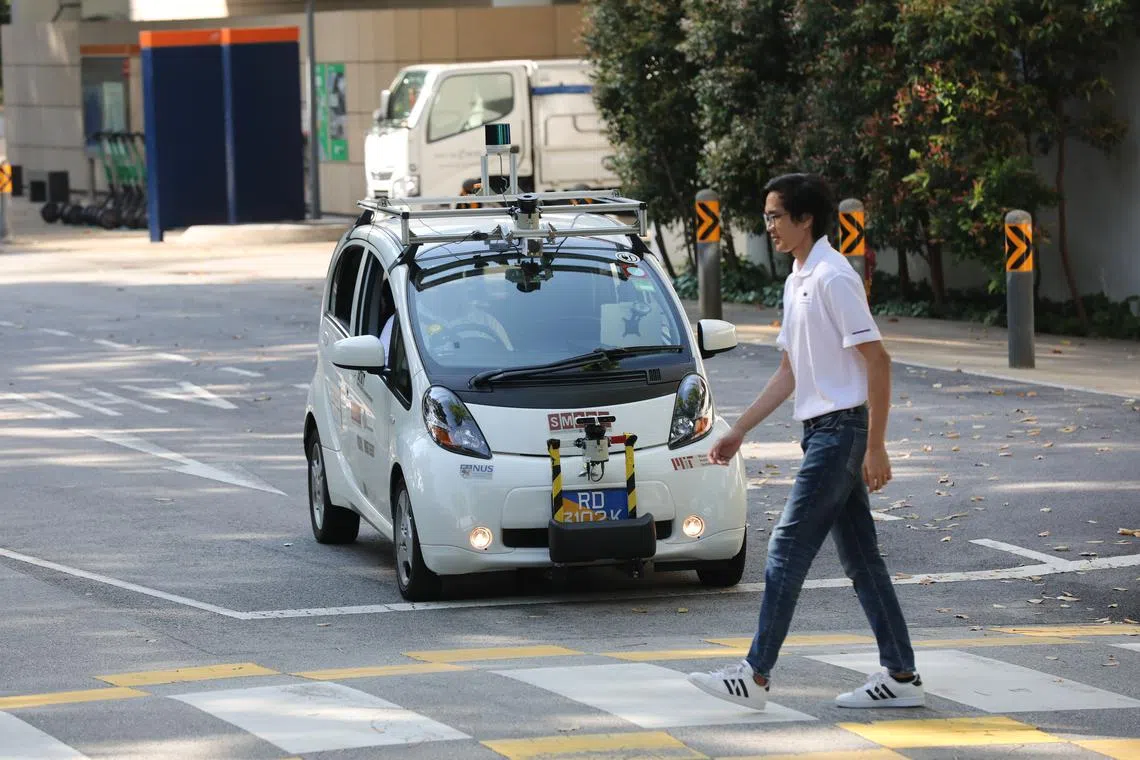LTA to test self-driving minibuses, goods vehicles on Singapore’s roads: Chee Hong Tat
Sign up now: Get ST's newsletters delivered to your inbox

A self-driving electric vehicle being tested on the road in University Town at the National University of Singapore.
PHOTO: ST FILE
Follow topic:
SINGAPORE – Self-driving minibuses and logistics vehicles might soon be navigating Singapore’s streets, as the Republic moves to deploy more of these autonomous vehicle (AV) technologies on the roads.
Transport Minister Chee Hong Tat said the authorities would focus on these two types of vehicles in the near term, because they can be deployed in scalable numbers along fixed routes, and mature examples of these technologies have been used commercially overseas.
“The deployment risks can be more carefully managed with lower vehicle speeds and time of use,” he added.
“Equally importantly, these use cases can help address our pressing manpower challenges in the logistics and public transport sectors, where it has been challenging for operators to hire drivers.”
Mr Chee was speaking to more than 5,000 transport professionals at the opening ceremony of the biennial Singapore International Transport Congress and Exhibition on Nov 6.
Already, the Land Transport Authority (LTA) has approved the use of self-driving vehicles in two instances – facility management firm Chye Thiam Maintenance’s electric robo-sweepers electric logistics vehicles
In both these instances, the AVs have passed LTA’s tests and have good track records overseas, said Mr Chee, who added that LTA is ready to work with other firms interested in tapping these vehicles.
There are now 13 AVs authorised for public road trials and used for logistics and as people-mover shuttles and road sweepers, according to LTA.
Mr Chee also said LTA would buy autonomous minibuses to deploy them here in partnership with a public bus operator.
This roll-out will begin on “less technically challenging” bus routes with lower traffic and ridership levels, before being expanded to more challenging routes after experience is gained from initial trials.
“The minibuses will also have a safety driver on board and will be monitored for reliability in the early days, before we transit to having a remote safety operator controlling the vehicle from afar,” said Mr Chee.
When asked, LTA said more details will be given when ready.
Mr Chee said Singapore was starting with these two types of AVs instead of robo-taxis, which are more challenging to operate as they travel on different routes to provide point-to-point services.
That said, he added that Singapore is open to exploring proposals involving robo-taxis.
Mr Chee cited the significant developments in the roll-out of driverless vehicles in China and the US, and said Singapore started rolling them out in 2015, but its progress in this area has been much slower than previously anticipated.
Acknowledging that the authorities want to move faster on this front, Mr Chee said it was also important to do so safely in the dense urban environment here, and ensure that different parts of the AV ecosystem are ready.
He pointed out that LTA has developed a revised testing and assessment framework that will test AV technologies from abroad in a circuit before deploying them on set real-world routes.
As part of this framework, LTA will closely monitor the performance data of these self-driving vehicles and assess their ability to operate safely and reliably in the local environment, including in conditions such as heavy rain, said Mr Chee.
Following that, the routes can be expanded progressively in scale and difficulty, subject to the vehicles’ performance.
LTA said it would brief industry players over the next two months, before it applies the revised framework to technologies that are ready.
“Before any AVs are put on the road, they will be programmed, tested and trialled thoroughly to minimise the risks. However, just as with human drivers, we must be mentally prepared that there will be some accidents involving AVs,” said Mr Chee.
When this happens, he said, the authorities would investigate and study the data before making an assessment about whether the AV would be safe to operate.
Not accepting any risk at all would mean Singapore would fall behind other cities, he added.
“Our approach cannot be to insist on ‘fail-safe’, but to design our systems to minimise risks and if failure were to happen, it will be ‘safe-fail’,” he said.
Mr Chee also said that the authorities would invest in training to upskill workers so they would be ready to work with AVs.
He added that LTA, the National Transport Workers’ Union and public transport operators have worked together to develop a skills and training road map for autonomous buses.
Chief executive Tony Han of Chinese self-driving technology company WeRide, whose autonomous minibus shuttle services started being trialled in Sentosa in May, said his firm would explore how to tap the revised testing framework to expand its deployment of driverless services to Singapore’s market.
He said some common challenges faced by operators rolling out AVs around the world include a lack of infrastructure – such as safe pick-up and drop-off points – to support operations, lack of public acceptance and the absence of clear regulations.

